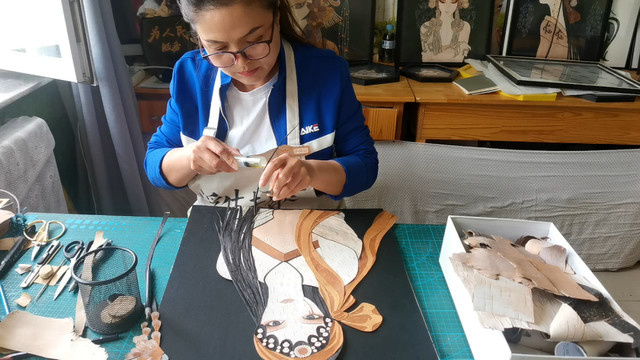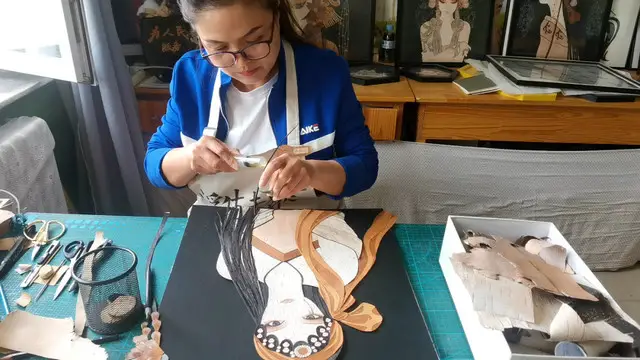By Zhang Cheng, People’s Daily

Photo shows Li Yanhong creates a bark painting. (Photo/wodsy.com)
“Bark of fallen trees and rotten wood can be turned into beautiful handicrafts through the deft hands of the locals. These skills are our secret of becoming rich,” Li Yanhong, a 44-year-old bark painting instructor, told the People’s Daily.
Li teaches her fellow villagers in Linsu village, Bailang township, Arxan, Hinggan League, North China’s Inner Mongolia autonomous region, to create bark paintings and handicrafts with materials such as white birch bark, pine bark, and moss.
Their bark paintings featuring beautiful women, flowers and birds depicted in traditional Chinese style and works featuring landscapes are so lifelike that many tourists are attracted to these products.
Li demonstrated the process steps for making bark painting works during the interview with the People’s Daily. She first sketched the basic patterns of the painting, and then peeled a piece of white birch bark layer after layer, after which she concentrated on details of the work using tools including scissors and gravers.
In a few moments, various small parts of the painting took shape. Li then pieced these parts together and pasted them onto a background board, and finally finished a simple bark painting after mounting and framing the work.
Li was born in the family of forestry workers and has been interested in bark painting since her childhood.
Endowed with rich forest resources, local people in Arxan often create various articles of everyday use with bark, such as cigarette cases and containers. Since she was young, Li has seen local women make bark paintings to give to their relatives and friends as gifts or to decorate their homes.
Under the influence of the older generations, Li has also created quite a lot of bark paintings featuring beautiful women and cartoon characters when she was young.
In the mid-1990s, Li went to study tailoring at a vocational school in Ulanhot, Inner Mongolia. After graduation, she worked in a clothing factory and made bark paintings in her spare time.
“Although I did not drop bark painting, I couldn’t earn a living through my craftsmanship, for there was neither a stable market nor a decent price for my works then,” Li said.
Thanks to China’s natural forest protection project, forests in Arxan were rehabilitated after the year 2000. Tourism industries in the city started to embrace rapid development and many local forestry workers turned from lumbering to tourism for income.
Li also started to ask people to sell the bark paintings she made in her spare time, and has since seen her income increase significantly each year.
At the end of 2017, Xie Caiyun, general manager of a local culture company based in Linsu village, saw Li’s works and persuaded her to return to her hometown and help people in the village achieve prosperity through bark painting techniques.
In May 2018, Li returned to Bailang township and became an instructor of the company. However, Li found herself faced with plenty of difficulties as there were not enough trained people on the job, and the bark painting products of the company could hardly find buyers because of the poor quality, outdated style, and high prices.
Realizing that the key to a breakthrough in the business was to find outstanding bark painting craftsmen, Li and Xie started to look for capable artists and invite them to work full-time on bark paintings. Zhao Guihua, a local villager who could make bark paintings since she was young, is one of them.
Under the guidance of Li, Zhao’s skills have been constantly improved in the past two years. At first, Zhao’s works were a little rough, but now she can make very delicate bark painting works and has become one of the first-class masters of the company.
“I devote most of my time to bark paintings now. My works are paid by piece. I can not only enjoy flexible work hours, but earn 40,000 ($5,864) to 50,000 yuan a year, which is much more than I used to make,” Zhao said.
In 2018, bark painting of Linsu village was included on the list of intangible cultural heritage (ICH) of Inner Mongolia. Later in March 2019, the region held a pilot training course for the integration of ICH into poverty relief efforts, inviting experts from Beijing Institute of Fashion Technology to train local bark painting producers.
“The training broadened our vision,” Li said, explaining that she and her colleagues are adding new materials to their products, paying more attention to the styles of their works, and developing various cultural and creative products based on bark painting techniques.
In an effort to involve more people in the business and guarantee stable growth in people’s incomes, Li has designed bark painting products that are easy to make and can be produced in large quantities.
At present, over 100 local people are working in the local bark painting industry, with their works being sold to other regions of the country. Each worker in the business now sees an average income growth of 1,000 to 2,000 yuan per month.
“We hold training sessions every month and teach students in accordance with their aptitudes,” Li pointed out. She has tried to improve the artistic quality of bark paintings by integrating traditional Chinese painting styles, traditional Chinese cultural elements, and the characteristics of the local forests.
“As the products become more beautiful, our sales volume and prices have risen and more people who are attracted to the craft have also increased their incomes,” said Li.
Li teaches her fellow villagers in Linsu village, Bailang township, Arxan, Hinggan League, North China’s Inner Mongolia autonomous region, to create bark paintings and handicrafts with materials such as white birch bark, pine bark, and moss.
Their bark paintings featuring beautiful women, flowers and birds depicted in traditional Chinese style and works featuring landscapes are so lifelike that many tourists are attracted to these products.
Li demonstrated the process steps for making bark painting works during the interview with the People’s Daily. She first sketched the basic patterns of the painting, and then peeled a piece of white birch bark layer after layer, after which she concentrated on details of the work using tools including scissors and gravers.
In a few moments, various small parts of the painting took shape. Li then pieced these parts together and pasted them onto a background board, and finally finished a simple bark painting after mounting and framing the work.
Li was born in the family of forestry workers and has been interested in bark painting since her childhood.
Endowed with rich forest resources, local people in Arxan often create various articles of everyday use with bark, such as cigarette cases and containers. Since she was young, Li has seen local women make bark paintings to give to their relatives and friends as gifts or to decorate their homes.
Under the influence of the older generations, Li has also created quite a lot of bark paintings featuring beautiful women and cartoon characters when she was young.
In the mid-1990s, Li went to study tailoring at a vocational school in Ulanhot, Inner Mongolia. After graduation, she worked in a clothing factory and made bark paintings in her spare time.
“Although I did not drop bark painting, I couldn’t earn a living through my craftsmanship, for there was neither a stable market nor a decent price for my works then,” Li said.
Thanks to China’s natural forest protection project, forests in Arxan were rehabilitated after the year 2000. Tourism industries in the city started to embrace rapid development and many local forestry workers turned from lumbering to tourism for income.
Li also started to ask people to sell the bark paintings she made in her spare time, and has since seen her income increase significantly each year.
At the end of 2017, Xie Caiyun, general manager of a local culture company based in Linsu village, saw Li’s works and persuaded her to return to her hometown and help people in the village achieve prosperity through bark painting techniques.
In May 2018, Li returned to Bailang township and became an instructor of the company. However, Li found herself faced with plenty of difficulties as there were not enough trained people on the job, and the bark painting products of the company could hardly find buyers because of the poor quality, outdated style, and high prices.
Realizing that the key to a breakthrough in the business was to find outstanding bark painting craftsmen, Li and Xie started to look for capable artists and invite them to work full-time on bark paintings. Zhao Guihua, a local villager who could make bark paintings since she was young, is one of them.
Under the guidance of Li, Zhao’s skills have been constantly improved in the past two years. At first, Zhao’s works were a little rough, but now she can make very delicate bark painting works and has become one of the first-class masters of the company.
“I devote most of my time to bark paintings now. My works are paid by piece. I can not only enjoy flexible work hours, but earn 40,000 ($5,864) to 50,000 yuan a year, which is much more than I used to make,” Zhao said.
In 2018, bark painting of Linsu village was included on the list of intangible cultural heritage (ICH) of Inner Mongolia. Later in March 2019, the region held a pilot training course for the integration of ICH into poverty relief efforts, inviting experts from Beijing Institute of Fashion Technology to train local bark painting producers.
“The training broadened our vision,” Li said, explaining that she and her colleagues are adding new materials to their products, paying more attention to the styles of their works, and developing various cultural and creative products based on bark painting techniques.
In an effort to involve more people in the business and guarantee stable growth in people’s incomes, Li has designed bark painting products that are easy to make and can be produced in large quantities.
At present, over 100 local people are working in the local bark painting industry, with their works being sold to other regions of the country. Each worker in the business now sees an average income growth of 1,000 to 2,000 yuan per month.
“We hold training sessions every month and teach students in accordance with their aptitudes,” Li pointed out. She has tried to improve the artistic quality of bark paintings by integrating traditional Chinese painting styles, traditional Chinese cultural elements, and the characteristics of the local forests.
“As the products become more beautiful, our sales volume and prices have risen and more people who are attracted to the craft have also increased their incomes,” said Li.
 Menu
Menu
 Bark painting helps villagers in N China’s Inner Mongolia increase income
Bark painting helps villagers in N China’s Inner Mongolia increase income
















